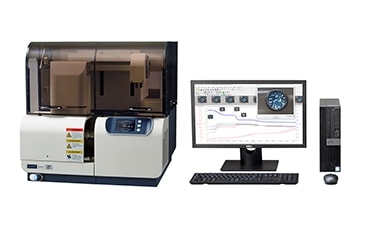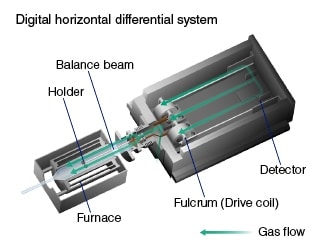—World-class High-Sensitivity Measurements for Testing and Component Analysis of Minute Sample Quantities—
Tokyo, Japan, May 9, 2019—Hitachi High-Technologies Corporation (TSE: 8036, Hitachi High-Tech) announced today that its wholly owned subsidiary and analytical instrument manufacturer and marketer Hitachi High-Tech Science Corporation (HHT Science) has developed the new “NEXTA STA Series” of thermal analyzers. The NEXTA STA Series enables high-sensitivity measurements through its world-class*1 baseline performance.*2HHT Science will launch the NEXTA STA Series in the Japanese and overseas markets.

NEXTA STA
“Thermal analyzer” is a generic term for an instrument designed to measure the basic thermal properties of materials (thermophysical properties). Some common techniques used to measure these properties are thermogravimetry (TG), which measures changes in weight, and differential thermal analysis (DTA) and differential scanning calorimetry (DSC), which measure changes in temperature. Thermal analyzers are used in various applications from research and development to quality control and fault analysis in a wide variety of fields ranging from organic materials such as plastics, composite materials, and pharmaceuticals, to inorganic materials such as ceramics and alloys.
In recent years, materials have seen increased functionality and complexity, and with this, the requirements for thermophysical assessment through the use of a thermal analyzer have become more diverse and sophisticated. In fault analysis of electronics, whose performance continues to improve, high baseline sensitivity is needed to analyze and measure the components of minute sample quantities. In addition, because of the widespread use of composite materials, it has become increasingly necessary to simultaneously acquire data on multiple components in a single measurement.
The NEXTA STA Series to be launched continues to employ the “Horizontal Digital Dual Beam System,”*3 which has an established reputation for high sensitivity even with conventional thermal analyzers. A newly introduced mechanism to keep the temperature of the balance section constant eliminates small errors in weight due to changes in the heating furnace temperature. With the above technologies, the NEXTA STA achieves world-class baseline performance.
Simultaneous TG-DTA measurements have been possible with conventional thermal analyzers. However, DSC can quantify the changes in the heat flow of a sample more precisely than DTA, and because of this, the customer’s need for simultaneous TG-DSC measurements has increased. With the improvement in heat-flow-measurement precision, HHT Science offers the capability of simultaneous TG-DSC measurements.
In addition to supporting the popular Real View® Sample Observation Thermal Analysis, the NEXTA STA has realized capabilities that can respond to the measurement needs of customers, such as improving the gas displacement performance.*1HHT Science investigation (as of April 2019)*2Baseline performance: In thermogravimetry (TG), baseline performance is determined by the ability to control weight fluctuations in the balance mechanism resulting from thermal expansion due to temperature changes.*3Horizontal Digital Dual Beam System: A thermogravimetric (TG) technique to improve performance using a balance mechanism. A balance inclination measurement part is placed on one side of the balance, the sample and a reference standard are placed on the other side, and properties of the sample and reference standard are each digitally processed.
Main Features
1.World-class TG baseline performance
The effect of temperature changes in the heating furnace on measurement results has been minimized by introducing a temperature control mechanism for the balance section. This produces a maximum weight fluctuation of 10 µg when a sample is heated in a furnace in an unset state from room temperature up to 1000 °C, resulting in world-class baseline performance.
2.The latest technology for TG-DSC measurement
The TG-DSC technique has advantages in quantifying the change in heat flow (temperature) compared to the simultaneous TG-DTA method employed by conventional thermal analyzers. The instrument supports multiple quantitative analyses based on a single measurement of changes in weight and heat flow.
3.Improvement in gas displacement performance
The gas displacement performance was improved by re-examining the design of the gas flow pathway.
4.Mass flow controller*4
A mass flow controller is provided as a standard feature for the first time by a Japanese manufacturer.*1 This improves the reliability of atmospheric control and operability.*4Mass flow controller to programmatically control the gas flow rate within the heating furnace.

[Cutaway Diagram]
*“Real View” is a registered trademark of Hitachi High-Tech Science Corporation in the U.S, Brazil, China, India, Turkey, the European Union, and Japan.
Media Inquiries
ContactKenichi Shibata
Marketing Dept., Business Strategy Div.
Hitachi High-Tech Science Corporation
TEL:+81-3-6280-0062
E-mail: kenichi.shibata.wg@hitachi-hightech.comFor Media InquiriesMasashi Mizutani, Emi Sato
CSR & Corporate Communications Dept.,CSR Div.,
Hitachi High-Technologies Corporation
TEL:+81-3-3504-3933
E-mail: masashi.mizutani.fh@hitachi-hightech.com





